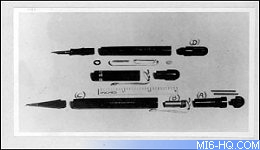Released MI5 documents give a real world insight behind James Bond
01-Mar-2005 • Bond News
So how much truth was there really in Ian Fleming's James Bond? Was it all the over-excited imagination of a writer - or did he let us in on things that really happened?
Ian Fleming spent World War II in naval intelligence - and biographers have charted how his experiences inspired him to create many of 007's finest adventures - reports the BBC.
But today MI5 has declassified secret documents shedding further light on the real history of James Bond.
The papers at the National Archives document the secret war to defend Gibraltar. They are a story of brilliant impersonators, femme-fatale agents and exploding fountain pens.

Above: Exploding fountain pen and pencil
What's more, they provide the full story of how an Italian plan for human torpedoes inspired Fleming to write Thunderball, made into one of the earliest Bond films.
During WWII, General Franco's Spain was nominally neutral - although hardly a friend of the Allies. And thanks to a personality clash of epic proportions between Franco and Hitler, Gibraltar was surprisingly spared direct assault.
But with the Germans, Spanish and Italians all wanting to prise the British from their Mediterranean colony, a secret war of spying, sabotage and smuggling began.
Fighting the British corner was the Security Intelligence Department, led by David Scherr. His personal history, declassified after 60 years, provides today's fascinating glimpse into counter-espionage.
Spanish workers continually smuggled items in and out of Gibraltar for the Axis powers. The key was to seize the weaponry without the Germans or Spanish catching on - but also to use some of it in bogus explosions to convince the enemy the saboteurs were getting through.
Gibraltar was a hotbed of spies and informers and Scherr's team knew it. At one point he paraded Field Marshall Montgomery in public - or rather his double - to confuse the enemy over British plans for the colony.
On other days, German double-agents would get the upper hand: false tip-offs would exhaust British agents as they searched market stalls for bombs hidden in vegetables.
But while the British generally kept a lid on the Germans and Spanish - foiling 70 attacks in four years - Scherr records the Italians were harder to crack.
The Italian secret weapon was the Tenth Flotilla MAS - frogmen who successfully hit 14 merchant vessels in three years.
The Italians had created special torpedoes that could be piloted by frogmen to their target, either from the beach of submarines.
"The normal method of approach was to travel on the surface until 80 to 100 yards from the target and then to submerge," Scherr records.
"Under the hull of the ship the MAS men would then leave their detachable warheads [and incendiary devices] and then escape to the Spanish shore using the torpedo to carry them to safety."
In true James Bond style, the saboteurs would then come ashore on the Spanish beach, strip out of their wetsuits and blend in until they could be picked up from a safehouse.
Growing in confidence, the team secretly adapted a 5,000 tonne tanker, the Olterra, which had been partially scuttled on the outbreak of war.
Cutting doors in the ship's bow, the Italians created flood chambers from which the human torpedo missions could be launched.
According to Ian Fleming's biographer, Andrew Lycett, the fledgling writer was so inspired by the idea when it passed over his desk at Naval Intelligence, he used it in Thunderball - the 1965 film of which is best known for Sean Connery's jetpack entrance.
In the film SPECTRE baddie Emilio Largo uses underwater doors and human torpedoes as the means to smuggle stolen nuclear weapons off his naturally luxurious yacht, the Disco Volante.
Back in the real world, the British were initially baffled by the attacks, thanks to some cunning disinformation put about by the enemy. But the Italians unfortunately had no idea how good the British double-agent network was to become.
One of the key double agents was a woman - one who more resembled Fleming's concept of the Bond girl.
Codenamed the Queen of Hearts, David Scherr describes their first encounter:
"This was a woman in her 30S whose dress, mannerisms speech and general appearance made her a rather seedy but not unattractive imitation of the seductive female spy of the thrillerette type," he recalls.
"She sat down, crossed her legs (adjusting her skirt to reveal them to the best advantage), slowly lit a cigarette, inhaled, breathed out the smoke in a furtive fashion, looking down her long aquiline nose at the same time, and then smiled across at her interrogator: 'I am the Queen of Hearts. Who are you?'"
A serendipitous tip from the Queen linked the frogmen to the Spanish authorities and a villa on the mainland. It was only a matter of time before the entire plot would unravel.
The grand Italian plan was to hit the Royal Navy hard in the winter of 1942.
Three torpedoes, each with two men onboard, would be launched from the Olterra. Lieutenant Lino Visentin would lead the attack against HMS Nelson, a battleship, and aircraft carriers HMS Furious and Formidable.
But it was not to be. Two of the torpedoes malfunctioned and had to be hastily repaired. As they again headed for their targets, naval gunners picked them up. Five of the six frogmen died in the hail of fire and depth charges.
The survivor escaped by diving the torpedo early - meaning he would not have enough air to complete the mission.
Although David Scherr's team would only later discover the Olterra's real role, the operation had essentially failed and the fleet was safe from attack.
Thanks to `Tom` for the alert.
 Discuss this news here...
Discuss this news here... 





